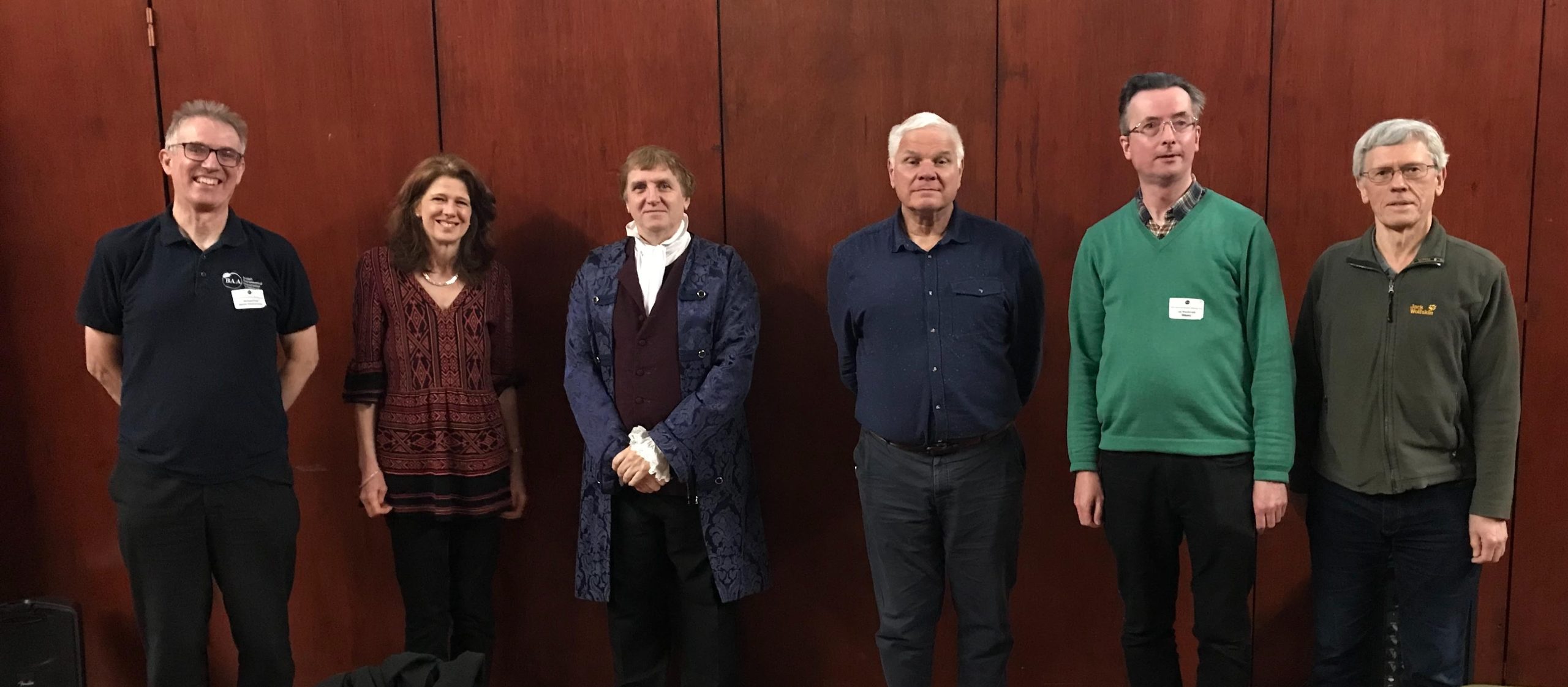2023 Historical Section Meeting
2023 October 10

Twenty-seven BAA members and guests attended the 2023 Historical Section Meeting, held in the Lyttelton Theatre at the Birmingham & Midland Institute in central Birmingham on Saturday, 2023 May 20. Mike Frost, the Section Director, opened the meeting at 10.00 a.m. with an introduction. This was followed by five talks interspersed with breaks for informal discussions.
The first speaker of the day was Mark Edwards, who presented a talk on the ‘Early History of the Jodrell Bank Observatory’. Bernard Lovell was a physicist who was seconded to Bawdsey on the Suffolk coast to work on radar for the duration of the Second World War. There he noticed some unexplained signals.
After hostilities ceased, he decided to follow up on the mystery by carrying initial radio-wavelength observations from central Manchester, but passing public-transport trams caused electrical interference, so the work was restarted out of the city at a botanical research farm at Jodrell Bank. The agricultural nature of the site meant much early work was carried out in simple wooden buildings and often knee-deep in mud when the weather was bad. One unusual experiment there was an investigation into the Earth’s magnetic field using a suspended 10cm-long solid-gold cylinder, borrowed from the vaults of the Bank of England. Mark’s presentation included sound recordings of some of the actual astronomers discussing their work.
The second speaker was Marie-Louise Archer, who told the meeting about the Islamic astronomer Ulugh Beg (1394–1449) and his observatory. Beg lived in Soltaniyeh, Timurid Empire (now Zanjan Province, Iran) and Samarkand (now Samarqand Region, Uzbekistan). He was state governor at the early age of 16. In 1428, Ulugh Beg built an observatory, similar to Tycho Brahe’s later Uraniborg. Beg achieved a high level of accuracy in his observations by building a very large naked-eye sextant; the so-called Fakhri sextant had a radius of about 36 metres (118 feet) and could separate down to one twentieth of a degree. Ulugh Beg used his observations to compose a star catalogue consisting of 1,018 stars. He determined the length of a year to within thirty seconds of its currently accepted value. In further work he looked at the axial tilt of the Earth. Beg was killed, along with his brother Abdal-Aziz, by Beg’s son Abdal-Latif Mirza in 1449.
The Birmingham & Midland Institute is home to the Society for the History of Astronomy’s (SHA) splendid Sir Robert Stawell Ball Library, and during the lunch break, several attendees took the opportunity to view the collection. The SHA also had a table of excess library stock for sale, which proved popular. Delegates were able to view a number of posters on Antipodean topics submitted by Prof Wayne Orchiston, who spoke at the Section’s previous meeting, a webinar in 2022.
After the lunch break, John Chuter informed the audience about ‘Some Recent Donations to the BAA Archives’. These included material relating to the solar eclipse in 1973 June, as well as videos of observations of the 2004 transit of Venus and a 2008 partial solar eclipse, observed from Patrick Moore’s home, Farthings, West Street, Selsey. A fourth video was, again, of Patrick Moore, but this time shot in Russia in 1960. John concluded by announcing that the BAA Archive was going online. Digitising work has been started in conjunction with Max Communications.
The next speaker was Lee Macdonald, who spoke on ‘Refugees, Star Clusters and Relativity: Astronomy at Greenwich Observatory in the First World War’. At the beginning of the 20th century, the Observatory staff were predominantly young and 100% male. By 1914 October, with the war just two months old, the staff of 61 had been reduced by nine. E. W. Maunder, who had retired in 1913, came back, initially on a voluntary basis. Ladies, including Annie Maunder, were used to replace the young men who left for military service. Another source of astronomers was the arrival of those displaced by the war, who came to the UK as refugees. These included Robert Jonckheere and P. J. Melotte.
There were two significant total solar eclipses during the period under discussion: one in 1914 and the second in 1919. A few observations of the first were carried out from Minsk; the observers only just got home before things hotted up. Their instruments, however, were sequestered in Russia until the mid-1920s. The 1919 eclipse was the famous one at which Arthur Eddington and others validated Einstein’s predictions of light bending. Lee concluded by saying that as Einstein was German, his work would probably not have been accepted in the UK had it not been transmitted through the Belgian astronomer Willem de Sitter, a trusted friend of Eddington’s – Lee’s research has uncovered this correspondence.
After a short refreshment break, the final speaker of the day was Andrew Lound, who gave an immersive presentation about ‘Herschel’s Lunatick Friends’. Andrew discussed the relationship between the astronomer William Herschel and the Birmingham Lunar Society. This group met in Matthew Boulton’s home, Soho House, to discuss scientific ideas of interest to them. Boulton’s business partner was the engineer James Watt and when they wanted to find out what other engineering firms were up to, they sent the famous scientist Herschel to find out the answers to questions they could not ask their rivals themselves.
Mike closed proceedings at 4.50 p.m. He thanked all those who had helped make the meeting happen.
Bill Barton, Historical Section Deputy Director
| The British Astronomical Association supports amateur astronomers around the UK and the rest of the world. Find out more about the BAA or join us. |
